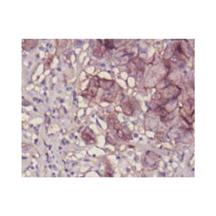Product Sheet CP10331
Description
BACKGROUND Ecto 5\' nucleotidase (NT5E, also known as CD73) is a glycosyl phosphatidylinositol (GPI)-anchored membrane protein that catalyzes the hydrolysis of extracellular AMP to adenosine. NT5E/CD73 regulates diverse physiological processes that are modulated by adenosine, including hypoxia, inflammation and epithelial ion transport. NT5E/CD73 also plays regulatory role in some biological processes independent of its catalytic activity. It was shown that NT5E/CD73 is a lymphocyte vascular adhesion protein, which mediates lymphocyte adhesion to endothelium and promotes lymphocyte cell migration. Moreover, in lymphocytes, antibody against NT5E/CD73, in combination with submitogenic concentrations of phorbol myristate acetate, induced strong activation of T cells that resulted in increased prolifera¬tion, secretion of interleukin (IL) 2, and expression of the IL 2 receptor. In addition, NT5E/CD73 is highly expressed in many human solid tumors. It was associated with tumor neovascularization, invasion, and metastasis.1 In normal breast epithelium, NT5E/CD73 was differentially expressed in lobular, ductal and myoepithelial cells, and was most frequently detected in the myoepithelial compartment. NT5E/CD73 level in the highly metastatic MDA MB 435 cells was much higher than normal mammary epithelial cells. NT5E/CD73 was negatively regulated by estrogen receptor a (ERa). NT5E/CD73 expression and its genera-tion of adenosine may relate to breast cancer progression. Therefore, increased expression of NT5E/CD73 in ER negative cells may serve as a novel marker for more aggressive breast carcinoma.2 Furthermore it was shown that NT5E/CD73 is expressed in peptidergic and nonpeptidergic nociceptive (pain-sensing) neurons and their axon terminals in spinal cord and skin. Moreover, it was demonstrated that NT5E/CD73 has antinociceptive effects in vivo and the long lasting antinociceptive effects of mNT5E are due to hydrolysis of AMP followed by activation of A1R.3 Recently, it was shown that deficiency of NT5E/CD73 led to symptomatic arterial and joint calcifications, which results from mutations in the NT5E/CD73 gene.4
REFERENCES
1. Wang, L. et al: J. Cancer Res. Clin. Oncol. 134:365-72, 2008
2. Zhou, P. et al: Cancer Biol. Therapy 6:426-31, 2007
3. Sowa, N.A. et al: Mol. Pain 6:20, 2010
4. Hilaire, C. S. et al: N Engl J Med 364:432-44, 2011
2. Zhou, P. et al: Cancer Biol. Therapy 6:426-31, 2007
3. Sowa, N.A. et al: Mol. Pain 6:20, 2010
4. Hilaire, C. S. et al: N Engl J Med 364:432-44, 2011
Products are for research use only. They are not intended for human, animal, or diagnostic applications.
Details
Cat.No.: | CP10331 |
Antigen: | Raised against recombinant human NT5E fragments expressed in E. coli. |
Isotype: | Mouse IgG1 |
Species & predicted species cross- reactivity ( ): | Human, Mouse, Rat |
Applications & Suggested starting dilutions:* | WB 1:1000 IP n/d IHC 1:50 - 1:200 ICC n/d FACS n/d |
Predicted Molecular Weight of protein: | 70 kDa |
Specificity/Sensitivity: | Detects endogenous NT5E proteins without cross-reactivity with other family members. |
Storage: | Store at -20°C, 4°C for frequent use. Avoid repeated freeze-thaw cycles. |
*Optimal working dilutions must be determined by end user.
Products
| Product | Size | CAT.# | Price | Quantity |
|---|---|---|---|---|
| Mouse NT5E/CD73 Antibody: Mouse NT5E/CD73 Antibody | Size: 100 ul | CAT.#: CP10331 | Price: $425.00 |

